A certain amount of transformation will occur naturally when implementing a newer Human Capital Management[1] (HCM) system. Newer functionality[7] can replace manual and customized system workarounds. Having different employees or leaders review processes, often initially implemented decades ago, can help update, streamline, and standardize them. The exercise of scrubbing and transforming data[17] for conversion[13], sometimes from multiple sources, including spreadsheets, can put your organization in a better place for reporting and metrics[18].
For an HCM systems implementation[6] to truly transform your HCM practices, it’s crucial to continuously review and update multiple practice areas a year or two before the implementation. This ongoing process[19] ensures that the system remains effective and relevant to your organization’s needs.
The project[20] clock starts ticking the minute a kickoff meeting begins. There are milestones and deadlines to meet with systems training, design, testing[21] cycles, end-user training, and ultimately, cutover and go live. For example, suppose you want to revise your performance management process. In that case, you need at least six months to get through exposure to leading practices, design, and socialization of the new process and approval by executives. Implementing a performance management module or system is typically a three-to-four-month process, so there isn’t time to think twice about your current practice when that begins.
There is a more strategic, broader perspective to enabling HCM transformation in your organization through implementing a system. HCM systems have robust functionality these days, so the question is no longer, “Can the system support this process?” but “What process do you want the system to support?” Do you want to “lift and shift” old processes and practices into a new system? Imagine if your new system’s go-live was the point people looked back to and said, “That enabled us to move into the future of multiple processes and practices for our organization!”.
Consider Your Stakeholders
Take a step backward to take a view of the groundwork that is often forgotten in the rush to get an HCM implementation started. Taking the time to identify and prioritize your stakeholders can make or break an HCM systems implementation. Think about your HR team, the IT team, executives, employees, managers, and external users such as job applicants. Each group has different expectations of and needs for an HCM system. Understanding and engaging with each stakeholder[14] group early and often will ensure that all parties have ownership over the project and set you on a path to successful adoption of the new system and a maximum ROI.

This article will cover six “success drivers” of an HCM implementation. Some of these are groupings of HR functions; others are callouts of specific areas that may be new to your consideration. All six drivers are critical to the success of your project.
Success Driver #1: Leadership Alignment and Vision
Is your leadership unified, and does it have a clear vision for a successful change implementation? Is your leadership committed to an HCM transformation vision? Is that vision aligned with the overall organizational strategy? Do you have advocacy for change and innovation among your leaders? Are your leaders willing to lead by example and by their sponsorship of the implementation? And will they back up their talk of support by ensuring resources are available for the implementation to be successful?
Leadership alignment plays a pivotal role in HCM implementations, fostering coherence, shared vision, and concerted efforts across all levels of the organization. Data underscores organizations’ need to prioritize and cultivate leadership alignment to achieve their HCM objectives. According to a report in LSA Global, organizations with high levels of leadership alignment are 72% more likely to outperform their competitors in terms of profitability and revenue growth (2020). The Harvard Business Review identified in 2017 that companies with strong organizational alignment are 2.9 times more likely to succeed in their transformation efforts. According to McKinsey, 70% of large-scale transformations fail to achieve their goals due to a lack of employee engagement[2] and inadequate management support (2016).
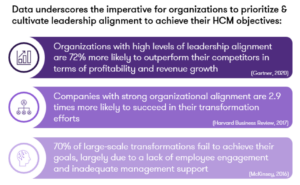
Some signs that your leadership focus and project vision require better alignment include the following:
- Leaders who do not understand the business case for change or vision for HCM transformation
- A lack of investment in the implementation, often evidenced by a lack of resource allocation
- Leaders who appear disengaged or indifferent to the journey ahead
An example of an implementation where leadership alignment did[26] not happen and negatively impacted the ROI of the new system can be illustrative. During a nine-month implementation of core HR[22] and another nine-month implementation of additional talent management modules, the HR executive would mention the implementation of the system periodically in regular C-suite level meetings. However, the executive did not conduct in-depth discussions of the implementation to engage the other leaders.
The first phase of this project was primarily a back-office optimization effort with minimal impact on stakeholders outside of HR. However, when the second phase implemented several talent management modules—goals, performance, compensation, learning and development, and talent acquisition—the head of one division refused to use several of the modules. Just mentioning an ongoing systems implementation in executive-level meetings, it turns out, does not lead to alignment among executives around actual implementation.
A more positive case study is a global food and beverage manufacturer and retailer we worked with to help prepare for AI[27] integration[8]. They were anticipating temporary disruptions to their people, culture, and processes. They realized they needed change management[3] support and leader alignment for senior executives and stakeholders while transitioning to a new technology vendor.
We conducted readiness assessments to identify transformation gaps. Then, we helped the organization build a coalition of executive champions. We developed a stakeholder engagement and communications plan and created consistent language and branding. Finally, we mapped out the impacts on the organization’s global stakeholders.
Ultimately, the organization was able to establish a structured and engaged leadership. They enhanced their leadership alignment with a people-first approach. This realignment enabled agile adaptation to changing work and technology landscapes, minimized disruption to daily operations, and positioned the organization for continued success in its multi-year transformation efforts.
Success Driver #2: Operating Model[23] and Design
An optimized organizational structure can maximize the success of your HCM system implementation. Most HCM systems need a hierarchy of organizational structure. When defining that structure is a challenge, it usually indicates that the organization’s operating model is not clearly defined or understood.
But what is an operating model? It is a blueprint for aligning business objectives with company strategy. An operating model structures roles and workflows for efficiency, with flexibility to adapt to changing needs and integration across business functions and technology, defining governance, processes, and procedures.
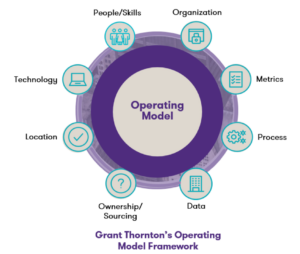
An organization, department, or team’s shift in its operating model creates an opportunity to examine and enhance how teams accomplish work, define roles, report relationships, and collaborate. With an efficient organization design, companies are 2.3 times more likely to exceed targets, 27 times more likely to engage and retain talent, and 13 times more likely to innovate effectively (The Definitive Guide to Organization Design: The Journey to Agile. Josh Bersin Company, May 2022).
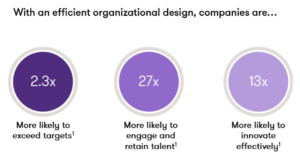
Some signs that your operating model/design requires focus include:
- Inconsistent organizational strategy and goals where different parts of the organization pursue independent goals, resulting in a lack of cohesive direction.
- Unclear roles and responsibilities, where there is confusion or overlap in roles, leading to duplicated efforts and gaps in accountability.
- Technology, data, and processes that lack coordination, with employees using different processes and tools across departments, creating inconsistency and inefficiency.
In the example where one division refused to use parts of the new system, the underlying issue was that that division had a completely different operating model — where most of the organization was non-profit, this division operated more like a for-profit entity[24]. Additionally, most of the organization had managers who had input into their direct reports’ pay increases, but this division had supervisors who were often peers and budget groups owned by higher-level staff who made all the pay decisions. As all the differences in rules, structure, and approval paths were understood, the organization realized they probably should have set this division up as a separate company. The division was eventually sold off because it was not part of the core business, so all the workarounds done in the system to accommodate their differences had to be back-engineered.
In contrast, consider a project where we helped a multinational financial services company implement a job architecture[9] framework[15] for pay equity and career transparency. Significant change impacts across HR, Finance, and other business departments required governance and standardization of processes to uphold the job architecture framework globally, and stakeholders were engaged to understand the job architecture impacts. Workshops were conducted to develop a future-state operating model, validate process flows, and identify change needs. Roadmaps were also designed to support the transition to implementation.
We delivered a comprehensive gap analysis[10] for informed decision-making, established a robust governance structure for ongoing maintenance[11], and created clear process-flow maps for enhanced clarity and efficiency. This enabled the organization to identify essential technology requirements for seamless integration.
Success Driver #3: Talent Strategy
You want to elevate talent management practices to impact your organization significantly. Several HCM practice areas cover the entire lifecycle of an employee. Suppose you need a comprehensive talent strategy for your organization built on understanding your operating model. In that case, your efforts in any of these areas may use something other than the differentiated return on investment[4] that was meant.
An effective talent strategy should:
- Align with the organization’s goals.
- Identify critical skills and competencies to facilitate robust recruitment, retention, and development and foster diversity, inclusion, and a culture of belonging.
- Continuously monitor and adjust as the organization’s needs and goals change.
In a rapidly expanding and competitive market, prioritizing talent management is crucial for organizations to attract and retain critical talent and unlock their workforce’s full potential.
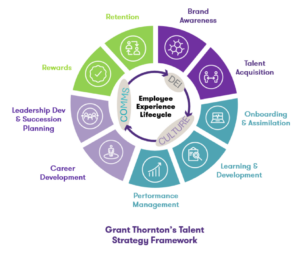
In Grant Thornton’s most recent CFO Survey, 67% of respondents said they face continued challenges to attract and retain the right talent, 40% said the future of their workforce is their top challenge, and only 45% said they are confident in their ability to meet their organization’s goals around labor needs.
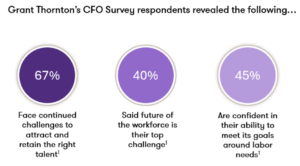
Some signs that your talent strategy requires better focus include:
- Your organization is unable to define what “good” looks like for any role or identify the critical skills needed for many roles.
- There is a cumbersome performance management practice that hinders rather than promotes development.
- Recruiting is a constant churn, and your candidate experience is poor.
- Succession planning[5] is based on subjective opinion without data to drive decisions.
One organization spent months developing competencies covering 40% of its population but needed help to roll them out consistently. They could not use the parts of the system built around competency functionality, including a more strategic approach to succession planning. Six years after the new system’s go-live, they lost all momentum in using competencies throughout the employee lifecycle. They reduced it to an optional activity employees could take on for their self-development.
Another organization asked us to facilitate a review of the organization’s talent strategy and employee lifecycle. They started with “hot jobs” and critical jobs, reimagining the recruiting processes to create a technology-forward, streamlined candidate journey from identification to onboarding[16], and realigned core competencies to foster more significant equity.
The enhanced recruiting experience was aligned on fit to a role rather than prior experience or certification. An objective basis for succession planning was established, with the evaluation of next-level competencies, rather than subjective opinion, used to determine successors. A more consistent application[12] of competencies across the organization fostered growth and development.
Be sure to grab the next issue of Workforce Solutions Review to get the second part of this article! In it we’ll look at three additional success drivers: a deeper dive into compensation practices as a more specific example, a look at the material in the upcoming HR operations section (in part 2) is focused on time records[25] and payroll, where Change Management is the sixth and final success driver. You’ll want to read it to get the full perspective and strategy!
References
LSA Global, https://bit.ly/3XiuAce
Harvard Business Review, https://bit.ly/4dGQ2gQ
McKinsey, https://bit.ly/4fUabBj
Grant Thornton’s CFO Survey, https://bit.ly/3ySNU6e
Human capital management (HCM) is the comprehensive set of practices for recruiting, managing, developing and optimizing the human resources of an organization.
Employee engagement, also called worker engagement, is a business management concept. An “engaged employee” is one who is fully involved in, and enthusiastic about their work, and thus will act in a way that furthers their organization’s interests.
A structured approach to changing the mindset and perceptions of individuals, groups and organizations to accept and implement new ideas and processes in an organization.
A capital budgeting metric in which the flow of benefits that results from an investment is compared with the cost of the investment, usually in the form of a ratio using the cost of the investment as the denominator.
The process of identifying internal candidates for leadership or other key roles within a company.




